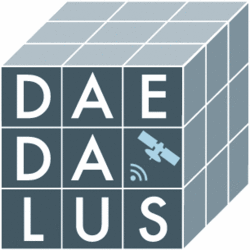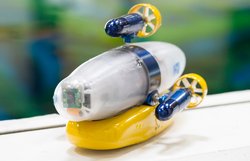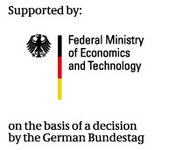DAEDALUS
Architectures and sensor data processing for energy-efficient control of self-powered tracking systems

Filedownloads
Project DAEDALUS Flyer ENProject DAEDALUS Flyer DE
System Flyer AUVx EN
System Flyer AUVx DE
Due to their high energy needs, their size and their limited field of application, existing tracking solutions do not offer a satisfactory solution to the long-term tracking of (small) objects. The aim of the DAEDALUS project was the development of technologies for low power tracking systems. A modular, adaptable tracking system for diverse applications, which can satisfy the most diverse requirements in a modular principle was implemented. Above that, the autonomous underwater vehicle AUVx was developed within the course of this project to demonstrate the usability of the tag technologies within a robotic context.
| Duration: | 01.08.2013 till 31.01.2017 |
| Donee: | German Research Center for Artificial Intelligence GmbH |
| Sponsor: |
Federal Ministry of Economics and Technology
German Aerospace Center e.V. |
| Grant number: | The project DAEDALUS is funded by the German Space Agency (DLR Agentur) with federal funds of the Federal Ministry of Economics and Technology in accordance with the parliamentary resolution of the German Parliament, grant no. 50NA1312 (DFKI). |
| Partner: | Fraunhofer IIS |
| Application Field: |
Underwater Robotics
Space Robotics |
| Related Projects: |
EurEx
Europa-Explorer
(12.2012-
04.2016)
|
| Related Robots: |
µAUV
|
Project details
Existing tracking systems are not capable of being used in different fields of application. For this reason, the DFKI together with Fraunhofer IIS has developed an energy-efficient tracking system which can be adapted to different scenarios. The developed system can be used both for indoor and outdoor. Goods, humans and animals can be tracked and parameters such as, e.g. vibration, temperature or pulse can be measured. The combination of different technologies such as GNSS and GSM were used. In combination, several tracking tags can use a common GSM connection and thus send data in an energy efficient way to a central visualization platform. With the help of energy harvesting, individual tags can be operated autarkic.
Within this project, the DFKI has implemented the software for the central control unit and developed the sensor board.
Furthermore, the autonomous underwater vehicle AUVX was developed within the DAEDALUS project. Inside the AUVX, the tracking tag serves as a central data hub for preprocessing and collecting sensor data and for sending the data to a visualization platform. This demonstrates the applicability of the developed technologies in a robotic context. The mission scenario for the AUVX is the EurEx mission scenario. Purpose of the AUVXX is to increase the accuracy of the position estimation as well as near field exploration.
During the development, particular attention was paid to its possible space application which resulted in an energy efficient design. In particular, the hull of the AUVX was optimized with the help of CFD simulations in order to be able to drive energy efficiently through the water. An FPGA was used for the low level control. Here, too, space is clearly visible as FPGAs have been successfully used in space for many years. In the development of the VHDL model, the project team was able to profit from an existing DFKI internal code base. In this context a radiation hardening concept (triple modular redundancy) was synthesized and evaluated concerning resource consumption for the first time at the institute.
The shape of the vehicle has been adapted such that the AUVX fits into the Icedrill developed within the EurEx project. Alltogether the AUVX combines capabilities, which are expected in much larger systems.
Videos
DAEDALUS: AUVx during an experiment at DFKI RIC

This video shows the AUVX inside test infrastructure at DFKI RIC. During its ride through the water the vehicle independently reaches waypoints which are marked with AprilTags. Fusing the data coming from the IMU with a model of the vehicle and data coming from computer vision algorithms enables the vehicle to pass the complete mission autonomously.
DAEDALUS: AUVx in the mission scenario of EurEx

This video animation shows the task of the AUVX within the EurEx mission scenario: Shortly after the icedrill melted through the iceshield of Jupiters moon Europa, several µGliders are released. The AUVX will determine the position of each µGlider and transmit the positions to the autonomous research vehicle Leng.


